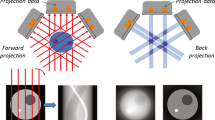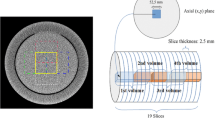Abstract
Background: Attenuation is a well recognized cause of reconstruction artifacts in SPECT imaging. Occasionally, we have noted an increase in activity extending from the apical septal portion of the ventricle in women with significant breast attenuation. Although the idea that attenuation can produce an increase in activity on the reconstructed images seems paradoxical at first, it is consistent with the process of filtered back projection. Methods: We filled a cardiac phantom with 1 mCi of Technetium-99m, placed it in a water filled anthropomorphic torso phantom and imaged it over a 180° orbit. Next, a breast phantom designed to simulate a significant degree of breast attenuation was placed on the torso phantom and imaging was repeated. The images were reconstructed first using conventional filtered back projection then with maximum likelihood. Results: When the phantoms with and without breast attenuation were reconstructed using filtered back projection and compared, the phantom with breast attenuation had a large ‘smear’ of activity extending anteriorly from the apical septal wall which was very similar to the abnormalities previously noted in clinical images; the phantom without breast attenuation had no such defect. This artifact was significantly less prominent when the images were reconstructed using the maximum likelihood technique. Conclusions: Attenuation artifact can also produce a seemingly paradoxical increase in counts on the reconstructed image but this phenomenon is consistent with the workings of filtered back projection.
Similar content being viewed by others
References
Eisner R, Churchwell A, Noever T, et al. Quantitative analysis of the tomographic thallium-201 myocardial bullseye display: critical role of correcting for patient motion. J Nucl Med 1988; 29: 91–97.
DePuey EG, Garcia EV. Optimal specificity of thallium-201 SPECT through recognition of imaging artifacts. J Nucl Med 1989; 30: 441–449.
Sorrell V, Figueroa B, Hansen CL. The “hurricane sign”: evidence of patient motion artifact on cardiac single-photon emission computed tomographic imaging. J Nucl Cardiol 1996; 3: 86–88.
Hansen CL, Siegel JA. Attenuation correction of thallium-SPECT using differential attenuation of thallium photons. J Nucl Med 1992; 33: 1574–1577.
Hansen CL, Heo J, Oliner C, Van Decker W, Iskandrian AS. Prediction of improvement of left ventricular function with Iodine-123 IPPA after coronary revascularization. J Nucl Med 1995; 36: 1987–1993.
Lange K, Carson R. EM reconstruction algorithms for emission and transmission tomography. J Comp Assist Tomogr 1984; 8: 306–316.
Snyder DL, Miller MI. The use of sieves to stabilize images produced with the em algorithm for emission tomography. IEEE Trans Nucl Sci 1985; NS-32: 3864–3872.
Beller GA. Diagnostic accuracy of thallium-201 myocardial perfusion imaging. Circulation 1991; 84: 11–16.
Goodgold HM, Rehder JG, Samucls LD, Chaitman BR. Improved interpretation of exercise T1–201 myocardial perfusion scintigraphy in women: characterization of breast attenuation artifacts. Radiology 1987; 165: 361–366.
Kaul S. A look at 15 years of planar thallium-201 imaging. Am Heart J 1989; 118: 581–601.
Manglos SH, Jaszczak RJ, Floyd CE, Hahn LJ, Greer KL, Coleman RE. Nonisotropic attenuation in SPECT: phantom tests of quantitative effects and compensation techniques. J Nucl Med 1987; 28: 1584–1591.
Kak AC, Slaney M. Principles of computerized tomographic imaging. New York: IEEE Press, 1987.
Di Bella EVR, Eisner RL, Barclay AB, Patterson RE, Nowak DJ. Attenuation artifacts in SPECT: effect of wraparound lung in 180 degrees cardiac studies. J Nucl Med 1996; 37: 1891–1896.
Manglos SH, Thomas FD, Gagne GM, Hellwig BJ. Phantom study of breast tissue attenuation in myocardial imaging. J Nucl Med 1993; 34: 992–996.
Author information
Authors and Affiliations
Rights and permissions
About this article
Cite this article
Hansen, C.L., Kramer, M. Attenuation smear: A ‘paradoxical’ increase in counts due to attenuation artifact. Int J Cardiovasc Imaging 16, 455–460 (2000). https://doi.org/10.1023/A:1010774426750
Issue Date:
DOI: https://doi.org/10.1023/A:1010774426750




